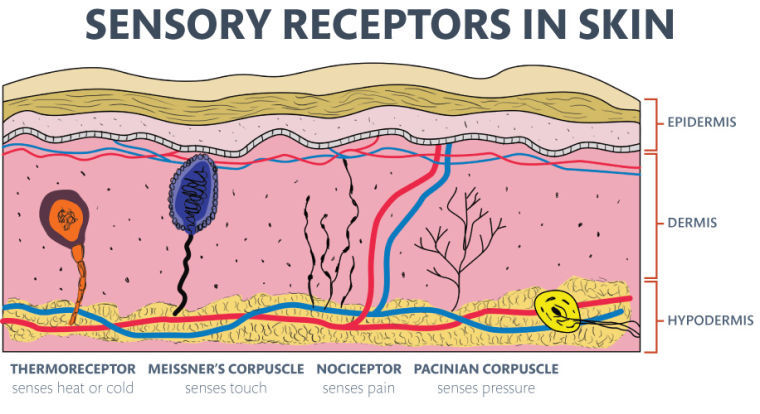Scientists closer to understanding sense of touch
Information from ExploringNature.org.
April 28, 2014
The physical world is made of shapes and solid objects that can be measured, distinguished and evaluated by the curious hand, but the way the human brain interprets them is a mystery that has always fascinated neurologists.
A study published April 16 in the journal Nature made a breakthrough in understanding touch by finding that Merkel cells, one of the four kinds of cells in the surface of the skin, allow humans to sense textures. These cells send signals to the brain that help humans determine the texture, density and shape of objects, according to Dr. Ellen Lumpkin, lead researcher on the study.
“[Sensing textures] is how these particular touch receptors provide the information to our brains about features or the shapes of the objects in the world around us,” Lumpkin said. “So if we want to type on a keyboard, if we want to write with a pen … this would all require the ability to detect object features.”
The scientific community grasps how sight, sound, smell and hearing work, but many of the mechanics relating to touch have eluded them until recent years, according to Steven Hsaio, a professor of neuroscience at Johns Hopkins University’s Mind/Brain Institute, who has been investigating the finer details of the senses for 25 years.
“If you hold a cup in your hand, how is the cup represented in the brain?” Hsaio said. “To recognize a cup, you have to know not only the spatial patterning on your skin, but also recognize where your hand is in space. You have to know what’s going on at both ends. So that’s [what] I’m working on—trying to understand the idea of how a shape is represented.”
Lumpkin said touch has been difficult to study unlike the other four senses, there is no distinctive sensory organ devoted to touch. Instead, the entire surface of the skin is a trigger area for the sense. To hone in on Merkel cells, Lumpkin used a fluorescent jellyfish protein to light up individual Merkel cells and pluck them out like Christmas lights.
“They both [respond to stimuli and connect with the brain], so that’s another thing that’s quite curious about these little touch receptors,” Lumpkin said. “They really seem to be doing both jobs. They send information to the brain about object features or object shapes, but they also report steady pressure.”
Lumpkin said the ratio of the Merkel cells to other epidermal cells fascinated her because they are so vastly outnumbered. The presence of Merkel cells links humans to the branch of the evolutionary tree that spurred the development of an internal spine rather than an exoskeleton. Insects and other invertebrates that possess exoskeletons do not have Merkel cells, she said. All vertebrate animals have Merkel cells and they are in virtually the same ratio among all vertebrates, Lumpkin said, which signaled to her that they must be important for animals’ sensing and shaping the environment.
However, the touch sensitivity Lumpkin connects with Merkel cells is only present in primates, according to Robert Martin, curator emeritus of biological anthropology at the Field Museum. He said the sensitivity of the fingertips is likely a trait that evolved from climbing trees about 18 million years ago.
Although it is still a developing field, touch has been the subject of scientific studies since the 1960s when scientists discovered and named touch receptors called the Meissner’s corpuscles. They play a role in developing the ridges on a fingertip, which allow fingers to grip surfaces more easily and a unique form of identfication. Martin wrote in his 1990 book “Primate Origins” that the ridges are likely an evolutionary trait that allowed for primates’ unique sensitivity.
“It’s rather like the ridges on a tire,” Martin said. “When you’re grasping something, those ridges on the skin [of the fingertip] are an anti-slip mechanism.”
The recent developments in the understanding of touch detailed in Lumpkin’s study could be used to develop medicine for conditions involving touch hypersensitivity, such as tactile allodynia and chronic itch. Chronic itch is the most prevalent skin disorder in the U.S. and can be extremely damaging to a person’s ability to function, according to an October 2011 study from the National Institutes of Health. Itch is poorly understood and is naturally the next step for sensory research, Lumpkin said.
“I think our goal is to bring relief to human suffering,” Lumpkin said. “By identifying these basic genes and cells that are involved in touch sensation, we hope to be able to inform the development of new therapies to relieve chronic suffering.”
Hsiao said although the study is a significant leap forward, touch research is far from complete because of its complexity. Lumpkin said the primary use of his findings for his own research will be to interpret how the Merkel cells communicate with the brain and how the brain then interprets those signals, sorts them and sends a transmission back to the nerve-endings in a person’s fingertips.
“We are missing this one piece,” Hsaio said. “We don’t know the specific neurotransmitter that is conveying [the signal]. There have been several unsuccessful attempts to identify it in the past but [Lumpkin and her team] will do it. [They will] get it there.”








